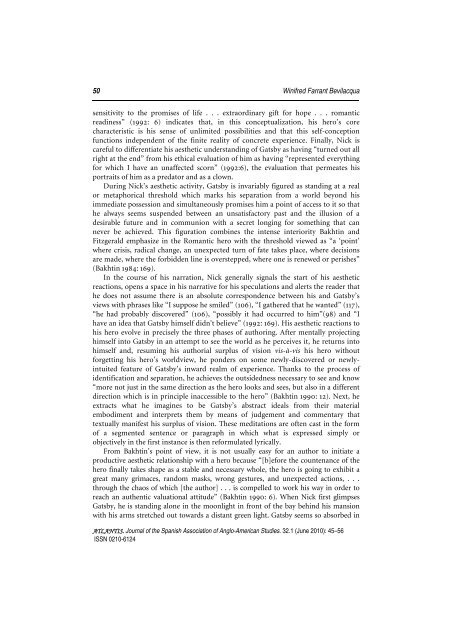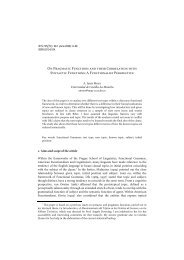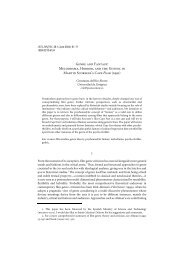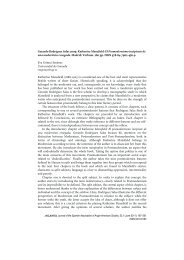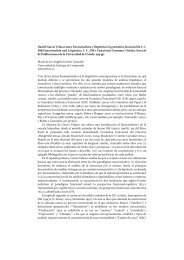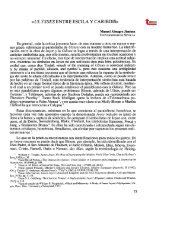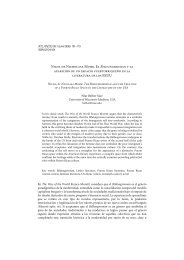Revista de la Asociación Española de Estudios Anglo - Atlantis
Revista de la Asociación Española de Estudios Anglo - Atlantis
Revista de la Asociación Española de Estudios Anglo - Atlantis
Create successful ePaper yourself
Turn your PDF publications into a flip-book with our unique Google optimized e-Paper software.
50 Winifred Farrant Bevi<strong>la</strong>cqua<br />
sensitivity to the promises of life . . . extraordinary gift for hope . . . romantic<br />
readiness” (1992: 6) indicates that, in this conceptualization, his hero’s core<br />
characteristic is his sense of unlimited possibilities and that this self-conception<br />
functions in<strong>de</strong>pen<strong>de</strong>nt of the finite reality of concrete experience. Finally, Nick is<br />
careful to differentiate his aesthetic un<strong>de</strong>rstanding of Gatsby as having “turned out all<br />
right at the end” from his ethical evaluation of him as having “represented everything<br />
for which I have an unaffected scorn” (1992:6), the evaluation that permeates his<br />
portraits of him as a predator and as a clown.<br />
During Nick’s aesthetic activity, Gatsby is invariably figured as standing at a real<br />
or metaphorical threshold which marks his separation from a world beyond his<br />
immediate possession and simultaneously promises him a point of access to it so that<br />
he always seems suspen<strong>de</strong>d between an unsatisfactory past and the illusion of a<br />
<strong>de</strong>sirable future and in communion with a secret longing for something that can<br />
never be achieved. This figuration combines the intense interiority Bakhtin and<br />
Fitzgerald emphasize in the Romantic hero with the threshold viewed as “a ‘point’<br />
where crisis, radical change, an unexpected turn of fate takes p<strong>la</strong>ce, where <strong>de</strong>cisions<br />
are ma<strong>de</strong>, where the forbid<strong>de</strong>n line is overstepped, where one is renewed or perishes”<br />
(Bakhtin 1984: 169).<br />
In the course of his narration, Nick generally signals the start of his aesthetic<br />
reactions, opens a space in his narrative for his specu<strong>la</strong>tions and alerts the rea<strong>de</strong>r that<br />
he does not assume there is an absolute correspon<strong>de</strong>nce between his and Gatsby’s<br />
views with phrases like “I suppose he smiled” (106), “I gathered that he wanted” (117),<br />
“he had probably discovered” (106), “possibly it had occurred to him”(98) and “I<br />
have an i<strong>de</strong>a that Gatsby himself didn't believe” (1992: 169). His aesthetic reactions to<br />
his hero evolve in precisely the three phases of authoring. After mentally projecting<br />
himself into Gatsby in an attempt to see the world as he perceives it, he returns into<br />
himself and, resuming his authorial surplus of vision vis-à-vis his hero without<br />
forgetting his hero’s worldview, he pon<strong>de</strong>rs on some newly-discovered or newlyintuited<br />
feature of Gatsby’s inward realm of experience. Thanks to the process of<br />
i<strong>de</strong>ntification and separation, he achieves the outsi<strong>de</strong>dness necessary to see and know<br />
“more not just in the same direction as the hero looks and sees, but also in a different<br />
direction which is in principle inaccessible to the hero” (Bakhtin 1990: 12). Next, he<br />
extracts what he imagines to be Gatsby’s abstract i<strong>de</strong>als from their material<br />
embodiment and interprets them by means of judgement and commentary that<br />
textually manifest his surplus of vision. These meditations are often cast in the form<br />
of a segmented sentence or paragraph in which what is expressed simply or<br />
objectively in the first instance is then reformu<strong>la</strong>ted lyrically.<br />
From Bakhtin’s point of view, it is not usually easy for an author to initiate a<br />
productive aesthetic re<strong>la</strong>tionship with a hero because “[b]efore the countenance of the<br />
hero finally takes shape as a stable and necessary whole, the hero is going to exhibit a<br />
great many grimaces, random masks, wrong gestures, and unexpected actions, . . .<br />
through the chaos of which [the author] . . . is compelled to work his way in or<strong>de</strong>r to<br />
reach an authentic valuational attitu<strong>de</strong>” (Bakhtin 1990: 6). When Nick first glimpses<br />
Gatsby, he is standing alone in the moonlight in front of the bay behind his mansion<br />
with his arms stretched out towards a distant green light. Gatsby seems so absorbed in<br />
ATLANTIS. Journal of the Spanish Association of <strong>Anglo</strong>-American Studies. 32.1 (June 2010): 45–56<br />
ISSN 0210-6124


